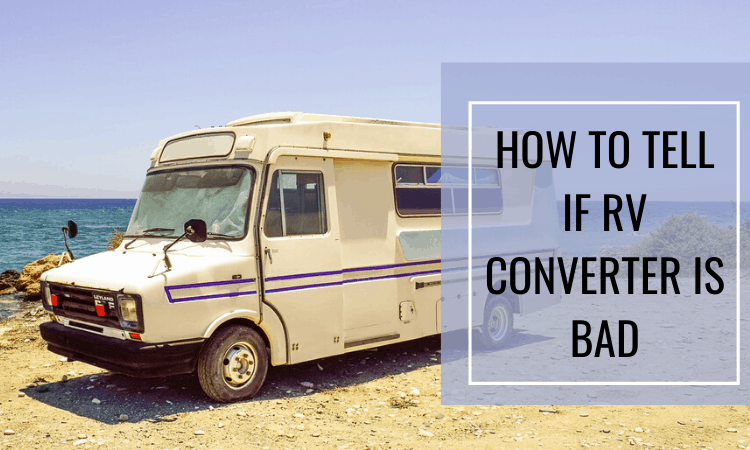How to Tell If the RV Converter Is Bad: Our Guide
- Airstream vs Oliver Comparison: Which Is The Best? - April 21, 2024
- The Best Travel Trailers for Jeep Wrangler On The Market - September 15, 2022
- The Best Travel Trailers Under 4000 lbs for Your Next Trips - September 15, 2022
Having all the comfort of your home even when you are hundreds of miles away from it, is one of the greatest advantages RVs have to offer.
However, you can only prepare a meal, watch your favorite TV show or listen to music in your RV if its electrical system is functioning properly. Running out of electricity while you’re on a vacation can cause all sorts of trouble, especially if you cannot get professional help easily.
If you’re having problems with your RV’s electrical system, the converter is one of the first things you need to check. So in this article, we are going to show you how to tell if an RV converter is bad.
Why is the RV converter so important?

The RV’s power supply can come from a generator, a solar panel, or the electric grid to which you connected your RV that generates 110V AC power. The batteries that supply power to the sockets in an RV can only produce 12V DC power.
This is where the converter gets in because the 110V alternating current has to be converted into 12V direct current. A malfunctioning converter will make the RV’s batteries the prime source of power, but as they get depleted you will start to notice that something is not right with the electrical system.
Getting a new converter can cost anywhere between $100 and $1600, depending on the converter model you get. Models like Powermax or Furrion can be reasonably priced, but you should also factor in the cost of the installation.
Attempting to install a new converter on your own isn’t a good idea unless you are an experienced electrician since even a minor mistake can cause irreparable damage to the RV’s electrical system.
The most common signs of a bad RV converter
A truck camper, a 5th wheel RV, and all other types of RVs utilize converters, but luckily spotting the first signs of a bad RV converter isn’t difficult. Dimming of lights in an RV is one of the first signs you’ll notice once the converter starts to go bad.
In addition, the fridge will struggle to maintain the same temperature, while other devices may also be operating at a limited capacity. Each of these signs indicates that sockets in your RV are not getting enough power, and the most common reason for this problem is a malfunctioning converter.
Here are some of the most common signs of a bad RV converter.
Batteries drain quickly
A converter is designed to supply 12V DC power to the RV’s batteries, and if you notice that the batteries are suddenly depleted this may indicate that the converter isn’t working.
You will have to test the batteries in order to make sure that they are still capable of holding a consistent charge. Make sure that the batteries are fully charged, then remove them from the RV and leave them for approximately half an hour and then use a multimeter to test the batteries.
A bad reading will indicate that the battery needs to be replaced, but if the batteries are still fully charged that means that the converter is the cause of the problem.
Converter cooling fan is not functioning properly
Converters need constant cooling to change the alternating current into the direct current. Overheating occurs when the cooling fan doesn’t start running after the temperature in the converter raises above the normal level.
High converter temperatures are one of the most common reasons why RV’s electrical system is malfunctioning. To rule this option out, you will have to do a voltage test at the point where AC enters the converter.
If the voltage tester shows the reading of 110V, chances are that either thermal sensor or thermostat needs to be replaced. A cooling fan cannot function, unless the current is running through it, and you should try to supply power directly to it in order to determine if it is still working.
In case it does, you will only have to replace the sensor. You should keep in mind that you need to get the exact same model, whether you are replacing a thermal sensor or the entire cooling fan because other models may not work on your RV.
Abnormal voltage range
Irregular voltage can also be an indicator of a bad RV converter and you can easily determine if this issue is causing the problem by measuring the voltage at the point where AC enters the converter.
The normal voltage reading on the multimeter should be between 108V and 130V at the entry point or 11V to 13V at the breaker box. Any reading that exceeds these values suggests new breakers have to be installed.
Moreover, an irregular voltage range may indicate that there is a short circuit and that you have to check the wires that go into the converter.
Clogged connections on a circuit board
Checking if the circuit board is causing the problems with the converter requires some previous experience and general knowledge about electronics. So, only attempt to do this if you consider yourself to be an experienced electrician.
Once you’ve opened the circuit board you should try to determine if there is any battery acid on the connections. The battery acid is a white substance that has a distinctive smell, which makes it relatively easy to spot.
In case you the battery acid leaked on connections you will have to clean it, but first, you must make sure that the electricity in your RV is switched off. Proceed to mix a tablespoon of baking soda with approximately 12oz of water and then use a cotton swab to remove the battery acid from connectors.
Leave the circuit board to dry after you’re done cleaning it, and then close it. If you continue to experience problems with the RV’s electrical system after you’ve removed the battery acid, it is highly likely that the RV’s converter is bad. Some RV models are equipped with circuit boards that have resistors to regulate the voltage that comes from 12 DC power sources. Resistors are commonly positioned behind the circuit board which makes them difficult to reach.
However, accumulated battery acid on resistor gates may suggest that resistors are faulty and you must seek the help of a professional in order to find out the best way to resolve this issue.
Defective diodes
Older RV models can be equipped with circuit boards that contain diodes that ensure that the power keeps flowing in the same direction and prevent it from changing the direction and causing damage to the RV’s electrical system.
Testing the diodes is a challenging task even for a skilled electrician, which is the reason why you should take your RV to a specialist if you suspect that diodes are causing the problem. Replacing the entire converter is your safest option in case diodes are broken, since it may be impossible to install new diodes on the converter.
Blown fuses
A sudden power surge or a short circuit can easily blow a fuse in the converter. Remove fuses from the converter one by one. If they look burnt or if the metal bridge seems broken you must replace them at once.
Make sure to check the back of the fuse to find the amp rating and ideally replace the blown fuse with a new one that has the same amp rating.
In emergency cases, you can use a fuse that has a lower amp rating, but this can only be a temporary solution and you should replace it with a fuse that has the same amp rating as all other fuses in the converter as soon as you can.
Unreliable power source
Having access to reliable power sources while you’re on the road can be difficult, as you can’t always know if the source to which you connected your RV is entirely reliable.
In some cases, a power source may be faulty which can cause dimming of the lights in the RV and mimic the symptoms of a bad converter. The best way to check if a power source is reliable is to connect a lamp or some other home appliance directly to the power pole.
If the appliance doesn’t behave as expected, then the problem doesn’t come from the RV converter but rather from the power source. This issue is particularly common in old campgrounds that don’t have sheltered power outlets.
That’s why it is not uncommon that a leak in an outlet after a storm can cause a short circuit that resembles the indicators of a bad RV converter.
The importance of regular maintenance checks

Heading out to your next adventure without doing a maintenance check on your RV can be a costly mistake that can potentially ruin your vacation.
RV’s electrical system requires routine checks, as even a seemingly insignificant issue can be difficult to fix. Without a converter, you will not be able to use any of the appliances you have in your RV, which is the reason why you should check it thoroughly before you start your journey.
Even though detecting if an RV converter is bad shouldn’t be too difficult, especially if you have the necessary tools, repairing or replacing a converter can be a highly technical task that should be done by a professional.
Follow this link to find more maintenance tips in our ultimate guide to RV maintenance.
Exploring the aftermarket options for RV converters
If you’ve determined that your RV converter is bad, you will have no other option but to replace it with an aftermarket model. Luckily, there are plenty of converters for RVs to choose from.
We’ve shortlisted a few converters that are perfectly suited for the RV application. Let’s take a look at what they have to offer.
Powermax PM3-55 Power Supply Converter

The fact that Powermac PM3-55 Power Supply Converter is available in several different sizes, makes it an attractive option for RV owners.
Furthermore, this RV converter is equipped with mounting flanges that allow for easy installation, and an AC power cord you can plug into any standard 110V or 120V power outlet. This is a 3-stage converter designed to shut down power automatically during a sudden power surge caused by a short circuit and keep your RV’s electrical system safe.
In addition, connecting the RV’s battery to the converter won’t take much more than a few moments of your time, as you just have to insert the wires into the junction on the converter and tighten the screws.
Features
- Automatic prevention against short circuits
- Standard AC power cord
- Features flanges that make the installation process easier
- Connecting the converter to RV’s batteries takes a minimum amount of effort
Pros
- Durable and affordable
- Equipped with smart chargers
Cons
- Noisy cooling fan
The Powermax PM3-55 is easy to install, it has an AC power cord you can plug into any standard 110V or 120V power outlet and can shut down power automatically during a sudden power surge.
WFCO WF-9855 Deck Mount Converter

In case you are looking for an RV converter that can also replace a faulty battery charger, then WFCO WF-9855 Deck Mount Converter is a great choice for you. This converter is also capable of delivering clean power to all appliances in your RV even without the battery filtering.
This 3-stage converter doesn’t interfere with TV or radio signals, and it won’t disrupt the operation of these devices in any shape or form. Moreover, the RV converter is designed for quiet operation, as its cooling fan is only activated when the electric load raises above the normal levels.
This WFCO’s model has an output capacity of 55 Amps DC, and it is available in several different sizes so that it can fit on different types of RVs.
Features
- The cooling fan is activated only when the electric load demands so
- Weighs 4.3 pounds
- The maximum power output is 55 Amps DC
- Automatic 3-stage battery charging feature
Pros
- Smooth and quiet operation
- Excellent protection against sudden power surges
Cons
- Limited warranty
In case you are looking for an RV converter that can also replace a faulty battery charger, then the WFCO WF-9855 Deck Mount Converter is a great choice for you.
Progressive Dynamics PD9260CV Inteli-Power 9200 Converter

Progressive Dynamics PD9260CV Inteli-Power 9200 Converter is equipped with a built-in charge wizard that makes the process of recharging RV’s batteries safer and quicker. Furthermore, the built-in reverse battery protection eliminates all chances of damage caused by a bad battery lead connection.
This 60V RV converter also limits the current and it reduces the voltage once the maximum voltage is reached. What’s more, it also features low line voltage protection that safeguards all appliances against all low voltage fluctuations.
There are four operating modes to choose from and you can switch between three different charging voltages, which enables you to control how much power you are using at any moment. The converter’s cooling capabilities leave much to be desired for, as it features a loud cooling fan.
Features
- 60V converter delivers filtered DC power to all RV’s appliances
- Reverse battery protection
- The voltage is reduced automatically after it reaches the maximum
- Excellent protection against low voltage oscillations.
Pros
- RV batteries can be recharged at three different voltages
- The battery voltage is constantly monitored
Cons
- More expensive than most RV converters
The Progressive Dynamics PD9260CV is equipped with a built-in charge wizard that makes the process of recharging RV’s batteries safer and quicker.
FAQs About bad RV converters
Can I change the converter’s cooling fan on my own?
Yes, you can, but you should make sure that the cooling fan you want to install matches the RV’s converter. Keep in mind that this process can be very technical, and it may be better to contact an electrician to avoid further complications.
How much does it cost to replace an RV converter?
The amount of money you can spend on a new RV converter can vary from a few hundred to more than a thousand dollars. In addition, you must enquire about the fee your electrician charges for this service.
Can an RV function normally without batteries?
An RV cannot function without batteries, which means that the RV’s converter also has to be functional so that you can use the power outlets in your RV.
How often do I have to replace the RV converter?
RV converters can last for years without going bad, and you don’t need to replace it unless it goes bad.
Conclusion
RV converter is connected to most electricity-related problems you can encounter in an RV. However, you don’t need to be a professional electrician to tell if the RV converter is bad, since dimmed lighting, oscillating fridge temperatures, or drained batteries can all indicate that there is something wrong with the converter.
The information we provided in this article should help you to determine if your RV converter has gone bad and assist you in resolving this issue. However, you shouldn’t change a bad converter on your own unless you are absolutely sure that you are up to the task.
Click here to find out more about the best RV roadside assistance plans.












